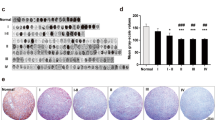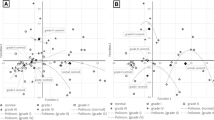Abstract
The neural cell adhesion molecule (NCAM) is involved in the intercellular junctions of neurons and glial cells. We investigated its relevance as a biomarker in gliomas which main characteristic is their high invasiveness.
We studied by Western blot the pattern of serum NCAM bands in patients with gliomas (n = 34), with brain metastasis of different primary cancers (n = 27) and with benign brain tumors (n = 22)] compared with healthy controls (n = 69). For densitometric analysis NCAM bands ≥130 kDa (HMW) and <130 kDa (LMW) were clustered. We observed that glioma patients presented higher NCAM HMW and lower NCAM LMW levels than control subjects (P < 0.01). A similar pattern was found in patients with brain metastasis or brain benign tumors, suggesting that the pattern of serum NCAM bands would be useful to detect brain tumor pathology. On the other hand, serum NCAM expression was not associated with the main clinicopathological features of gliomas, including overall survival. Interestingly, we found that 9/12 patients with glioma showed a significant decrease in NCAM HMW/LMW ratio between 1–3 months after successful tumor removal. Thus, serum NCAM could be a useful marker for monitoring treatment.
NCAM expression was also analyzed at tissular level in 59 glioma sections from paraffined tumors. We observed that NCAM immunostaining was inversely correlated with the histological grade of malignancy, remaining this association in a multivariate analysis. Besides, loss of NCAM staining was significantly associated with bad prognosis in an univariate analysis.







Similar content being viewed by others
References
Walsh FS, Doherty P (1997) Neural cell adhesion molecules of the immunoglobulin superfamily: role in axon growth and guidance. Annu Rev Cell Dev Biol 13:425–456
Burg MA, Halfter W, Cole GJ (1995) Analysis of proteoglycan expression in developing chicken brain: characterization of a heparan sulfate proteoglycan that interacts with the neural cell adhesion molecule. J Neurosci Res 41:49–64
Prag S, Lepekhin EA, Kolkova K et al (2002) NCAM regulates cell motility. J Cell Sci 115:283–292
Panicker AK, Buhusi M, Thelen K et al (2003) Cellular signalling mechanisms of neural cell adhesion molecules. Front Biosci 8:d900–911
Gower HJ, Barton CH, Elsom VL et al (1988) Alternative splicing generates a secreted form of N-CAM in muscle and brain. Cell 55:955–964
Goridis C, Brunet JF (1992) NCAM: structural diversity, function and regulation of expression. Semin Cell Biol 3:189–197
Crossin KL, Chuong CM, Edelman GM (1985) Expression sequences of cell adhesion molecules. Proc Natl Acad Sci USA 82:6942–6946
Ni Dhuill CM, Fox GB, Pittock SJ et al (1999) Polysialylated neural cell adhesion molecule expression in the dentate gyrus of the human hippocampal formation from infancy to old age. J Neurosci Res 55:99–106
Hampel H, Korschenhausen DA, Schwarz MJ et al (1997) Detection of the novel cell adhesion molecule MUC18 in human brain tissue. Neuroimmunomodulation 4:57–61
Ronn LC, Berezin V, Bock E (2000) The neural cell adhesion molecule in synaptic plasticity and ageing. Int J Dev Neurosci 18:193–199
Cotman CW, Hailer NP, Pfister KK et al (1998) Cell adhesion molecules in neural plasticity and pathology: similar mechanisms, distinct organizations? Prog Neurobiol 55:659–669
Ricard CS, Pena JD, Hernandez MR (1999) Differential expression of neural cell adhesion molecule isoforms in normal and glaucomatous human optic nerve heads. Brain Res Mol Brain Res 74:69–82
Huerta S, Srivatsan ES, Venkatesan N et al (2001) Alternative mRNA splicing in colon cancer causes loss of expression of neural cell adhesion molecule. Surgery 130:834–843
Tezel E, Kawase Y, Takeda S et al (2001) Expression of neural cell adhesion molecule in pancreatic cancer. Pancreas 22:122–125
Sasaki H, Yoshida K, Ikeda E et al (1998) Expression of the neural cell adhesion molecule in astrocytic tumors: an inverse correlation with malignancy. Cancer 82:1921–1931
Lantuejoul S, Laverriere MH, Sturm N et al (2000) NCAM (neural cell adhesion molecules) expression in malignant mesotheliomas. Hum Pathol 31:415–421
Gluer S, Schelp C, Madry N et al (1998) Serum polysialylated neural cell adhesion molecule in childhood neuroblastoma. Br J Cancer 78:106–110
Fogar P, Basso D, Pasquali C et al (1997) Neural cell adhesion molecule (N-CAM) in gastrointestinal neoplasias. Anticancer Res 17:1227–1230
van Kammen DP, Poltorak M, Kelley ME et al (1998) Further studies of elevated cerebrospinal fluid neuronal cell adhesion molecule in schizophrenia. Biol Psychiatry 43:680–686
Lynch DF Jr., Hassen W, Clements MA et al (1997) Serum levels of endothelial and neural cell adhesion molecules in prostate cancer. Prostate 32:214–220
Chang H, Bartlett ES, Patterson B et al (2005) The absence of CD56 on malignant plasma cells in the cerebrospinal fluid is the hallmark of multiple myeloma involving central nervous system. Br J Haematol 129:539–541
Todaro L, Puricelli L, Gioseffi H et al (2004) Neural cell adhesion molecule in human serum. Increased levels in dementia of the Alzheimer type Neurobiol Dis 15:387–393
Louis DN, Pomeroy SL, Cairncross JG (2002) Focus on central nervous system neoplasia. Cancer Cell 1:125–128
Demuth T, Berens ME (2004) Molecular mechanisms of glioma cell migration and invasion. J Neurooncol 70:217–228
Michotte A, Neyns B, Chaskis C et al (2004) Neuropathological and molecular aspects of low-grade and high-grade gliomas. Acta Neurol Belg 104:148–153
Kleihues P, Ohgaki H (1999) Primary and secondary glioblastomas: from concept to clinical diagnosis. Neuro-oncol 1:44–51
Ware ML, Berger MS, Binder DK (2003) Molecular biology of glioma tumorigenesis. Histol Histopathol 18:207–216
Zhou YH, Hess KR, Liu L et al (2005) Modeling prognosis for patients with malignant astrocytic gliomas: quantifying the expression of multiple genetic markers and clinical variables. Neuro-oncol 7:485–494
Laemmli UK (1970) Cleavage of structural proteins during the assembly of the head of bacteriophage T4. Nature 227:680–685
Mossman D, Somoza E (1991) ROC curves, test accuracy, and the description of diagnostic tests. J Neuropsychiatry Clin Neurosci 3:330–333
Besson A, Yong VW (2001) Mitogenic signaling and the relationship to cell cycle regulation in astrocytomas. J Neurooncol 51:245–264
Sanson M, Thillet J, Hoang-Xuan K (2004) Molecular changes in gliomas. Curr Opin Oncol 16:607–613
Wittekind C, Neid M (2005) Cancer invasion and metastasis. Oncology 69(Suppl 1):14–16a
Edvardsen K, Brunner N, Spang-Thomsen M et al (1993) Migratory, invasive and metastatic capacity of NCAM transfected rat glioma cells. Int J Dev Neurosci 11:681–690
Edvardsen K, Pedersen PH, Bjerkvig R et al (1994) Transfection of glioma cells with the neural-cell adhesion molecule NCAM: effect on glioma-cell invasion and growth in vivo. Int J Cancer 58:116–122
Figarella-Branger DF, Durbec PL, Rougon GN (1990) Differential spectrum of expression of neural cell adhesion molecule isoforms and L1 adhesion molecules on human neuroectodermal tumors. Cancer Res 50:6364–6370
Frost G, Patel K, Bourne S et al (1991) Expression of alternative isoforms of the neural cell adhesion molecule (NCAM) on normal brain and a variety of brain tumours. Neuropathol Appl Neurobiol 17:207–217
Lantuejoul S, Moro D, Michalides RJ et al (1998) Neural cell adhesion molecules (NCAM) and NCAM-PSA expression in neuroendocrine lung tumors. Am J Surg Pathol 22:1267–1276
Nybroe O, Linnemann D, Bock E (1989) Heterogeneity of soluble neural cell adhesion molecule. J Neurochem 53:1372–1378
Owens GC, Orr EA, DeMasters BK et al (1998) Overexpression of a transmembrane isoform of neural cell adhesion molecule alters the invasiveness of rat CNS-1 glioma. Cancer Res 58:2020–2028
Nakata D and Troy FA, 2nd (2005) Degree of polymerization (DP) of polysialic acid (polySia) on neural cell adhesion molecules (N-CAMS): development and application of a new strategy to accurately determine the DP of polySia chains on N-CAMS. J Biol Chem 280:38305–38316
Suzuki M, Suzuki M, Nakayama J et al (2005) Polysialic acid facilitates tumor invasion by glioma cells. Glycobiology 15:887–894
Kontogianni K, Nicholson AG, Butcher D et al (2005) CD56: a useful tool for the diagnosis of small cell lung carcinomas on biopsies with extensive crush artefact. J Clin Pathol 58:978–980
Liu J, Zheng S, Yu JK et al (2005) Serum protein fingerprinting coupled with artificial neural network distinguishes glioma from healthy population or brain benign tumor. J Zhejiang Univ Sci B 6:4–10
Kleinschmidt-Demasters BK, Rojiani AM, Filley CM (2006) Central and extrapontine myelinolysis: then ... and now. J Neuropathol Exp Neurol 65:1–11
Onodera H, Nagayama S, Tachibana T et al (2005) Brain metastasis from colorectal cancer. Int J Colorectal Dis 20:57–61
Acknowledgements
This work was supported in part by the following grants: Préstamo BID 1201/OC-AR PICT 4926 and Préstamo BID 1728/OC-AR PICT 11217 (SECYT).
Author information
Authors and Affiliations
Corresponding author
Additional information
Laura Todaro, Elisa Bal de Kier Joffé and Lydia Puricelli are members of the National Council of Scientific and Technical Research (CONICET).
Rights and permissions
About this article
Cite this article
Todaro, L., Christiansen, S., Varela, M. et al. Alteration of serum and tumoral neural cell adhesion molecule (NCAM) isoforms in patients with brain tumors. J Neurooncol 83, 135–144 (2007). https://doi.org/10.1007/s11060-006-9312-0
Received:
Accepted:
Published:
Issue Date:
DOI: https://doi.org/10.1007/s11060-006-9312-0




